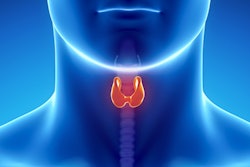A nomogram model based on O-RADS ultrasound findings and clinical and laboratory indicators can predict malignancy risk in ovarian masses, according to research published November 18 in BMC Medical Imaging.
A team led by Qiuxiang Chen, MD, from Shenzhen Second People’s Hospital in China reported that the model demonstrated high predictive performance in assessing adnexal cystic-solid masses, reducing the incidence of missed diagnoses and misdiagnoses.
“It [positions] itself as a potentially significant tool for personalized diagnosis of ovarian adnexal masses,” the Chen team wrote.
Ovarian cancer can be tricky to diagnose, since women are typically asymptomatic during the disease’s early stages. Early detection leads to better prognosis, with O-RADS ultrasound being the standard. However, the researchers pointed out that O-RADS is limited in terms of specificity and accuracy, and its sensitivity can lead to the misdiagnosis of benign masses as malignant.
Chen and colleagues developed a nomogram model based on O-RADS ultrasound and clinical and laboratory indicators to predict malignancy risk of adnexal cystic-solid masses.
To build the nomogram, they collected data between 2021 and 2023 from women with these masses who underwent ultrasound; the masses were confirmed by pathology. The team categorized the findings into benign and malignant groups according to pathological results, and used a regression analysis method called least absolute shrinkage and selection operator (LASSO) to select the most relevant predictors of ovarian cancer.
After constructing the nomogram, the researchers bootstrapped the data 500 times to perform internal verification. They also drew a calibration curve to verify the prediction ability and performed a decision curve analysis to assess clinical usefulness.
The study included 399 women with adnexal cystic-solid masses, of whom 327 were benign and 72 were malignant. Using LASSO, the team determined five predictors associated with the risk of malignancy: O-RADS, acoustic shadowing, postmenopausal status, CA125 (a serological marker for epithelial ovarian cancer), and HE4 (a novel biomarker found at high levels in ovarian cancer).
The model achieved high marks when it came to area under the curve (AUC), sensitivity, specificity, and other measures.
| Performance of nomogram model on predicting malignancy in adnexal cystic-solid masses | |
|---|---|
| Measure | Result |
| AUC | 0.909 |
| Sensitivity | 83.3% |
| Specificity | 82.9% |
| Accuracy | 83% |
| Positive predictive value | 51.7% |
| Negative predictive value | 95.8% |
To compare, O-RADS by itself achieved an AUC of 0.82, 93.1% sensitivity, and 64.2% specificity, respectively.
The calibration curve of the nomogram showed good consistency between the predicted and actual probabilities. Finally, decision curve analysis also showed good clinical usefulness, suggesting that women with adnexal masses can benefit from the constructed model over a considerable range of thresholds.
The study authors highlighted that the nomogram provides an intuitive, individualized tool for clinical decision-making. It can help clinicians better assess malignancy risk and formulate appropriate diagnostic and treatment plans, they added.
“In practical applications, clinicians can locate the corresponding scores on the nomogram based on various patient parameters and sum these scores to obtain the total points,” the authors wrote. “If the total score exceeds 145 points, further examination was advised due to the higher probability of malignancy.”
The team called for future large-scale multicenter prospective studies to further validate the model and improve its reliability and applicability.
The full study can be found here.



















